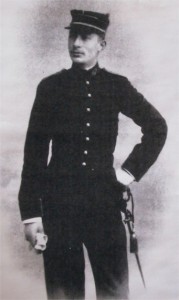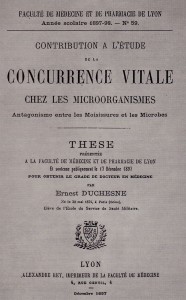Geek of the Week: Ernest Duchesne
By Joe Luna
What do guinea pigs, gorgonzola cheese, and tap water have in common? No, you’re not about to have some bizarre meal.
It’s a bit of a trick question, as they don’t really have anything in common. But if you were a French medical student in the mid-1890’s with a thesis to propose, these items would have been your scientific reagents. And if you were a particularly brilliant medical student at the time named Ernest Duchesne (born 30 June 1874), you would have used these reagents to discover antibiotics, a full 35 years before Alexander Fleming.
We’ve all heard the apocryphal story of Fleming’s forgotten bacterial cultures, ruined with contaminating mold over a long weekend. And then the great Eureka moment in science, when Fleming, perhaps as he was about to throw the cultures away, noticed that the mold had a halo around it of dead bacteria. It was then, we’re told, that the lightbulb of antibiotics began to flicker. But that’s not the full story. Fleming wasn’t the first to notice the anti-bacterial properties of various molds (we can thank the ancient Egyptians for that). Nor was he the first to demonstrate experimentally that the mold could cure a bacterial infection; that the mold harbored an “anti-biotic” in the sense we know today.

That honor goes to our GOTW Ernest Duchesne. Not much is known of his early life, save that he was born in Paris and that he entered the military medical school of Lyon in 1894. Duchesne became fascinated with microbes in medical school and opted to do his thesis under the guidance of Gabriel Roux, a microbiology professor and expert on fungi. Roux, who also directed a municipal laboratory in charge of monitoring the Lyon water supply, got Duchesne and his thesis work going with the following observation: tap water was never moldy, yet mold could grow quite well in distilled water. Roux suggested to Duchesne that the bacteria in the tap water might be preventing mold growth. Duchesne looked into it.
He grew Penicillium glaucum (the mold used to make gorgonzola, stilton, and other blue cheeses) and placed some in tap water and some in distilled water. As expected, the mold died quickly in the tap water, but persisted in the distilled water. Duchesne grew more P. glaucum, only this time he added bacteria commonly found in water, S. typhi (the typhoid fever bug) or E. coli, directly to the culture. The result was the same as in tap water: the mold quickly died.
So it appeared that the bacteria present in the water seemed to kill or otherwise outcompete the mold. Duchesne repeated the experiment altering many variables (broth composition, pH, temperature) and the result was the same with only minor variation. The bacteria always won, though in certain instances the mold seemed to not die as fast.
It was then that Duchesne asked an important question: Were there no circumstances where the mold could win? Or even more to the point, does the mold even put up a fight against the bacteria? Can it diminish bacterial virulence? Duchesne started answering these questions by taking a closer look at the conditions where the mold seemed to do moderately well against the bacteria. This led him to the following experiments in rodents. He first injected guinea pigs with S. typhi or E. coli. A day later, the guinea pigs were all dead. He then injected a second set of guinea pigs with an equal mixture of S. typhi and P. glaucum. The result was that the guinea pigs got sick, but they recovered! He then took the same guinea pigs and injected them again with the bacteria/mold mixture and the guinea pigs did not get sick. He performed the same experiments with E. coli and found the same result: P. glaucum somehow altered the virulence of the bacteria enough that the bacteria were no longer lethal. By injecting the mold into a guinea pig with a bacterial infection, Duchesne could cure the animal. A similar experiment, 35 years later, made Alexander Fleming a household name.

So why do we not remember Duchesne as the discoverer of antibiotics? There are a few reasons. While Duchesne demonstrated the anti-bacterial actions of molds and even alluded to their possible use to treat human infections, he did so with quite a wimpy mold (P. glaucum) as opposed to P. notatum, which is the mold that actually produces penicillin (first isolated as “mold juice” by Fleming and later purified by Chain, Heatley and Florey). P. glaucum was later shown to produce patulin, a much weaker antibiotic that is only effective at higher, and generally toxic, concentrations. So it may have been a tragic case of right experiment, right conclusion, wrong mold!
The famous though still somewhat spurious story that the Pasteur Institute rejected Duchesne’s thesis on the grounds that he was too young (23) and a relative unknown, certainly doesn’t help. I doubt however, that Duchesne would have missed penicillin if given more time (and health). His studies came to an end in 1897 when he received his medical degree. Following a year-long residency, he was appointed as a 2nd class major of medicine in the French army. He conducted no further experiments, and never published again. Indeed, his life after medical school was tragic. His wife of two years died of tuberculosis in 1903. In 1904, Duchesne succumbed to a pulmonary infection, probably also tuberculosis, and spent the rest of his life in-and-out of sanitariums until his death in 1912.
Still, despite a bitter end both to his life, and his work, to the latter we can append a hard-fought “almost.” In 1949, five years after Fleming, Chain and Florey won the Nobel Prize for the discovery and isolation of penicillin, Duchesne was posthumously honored upon the re-discovery of his thesis.
